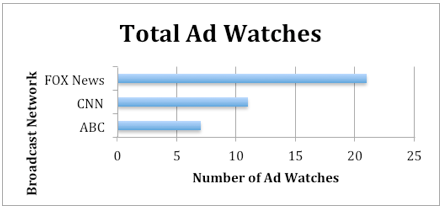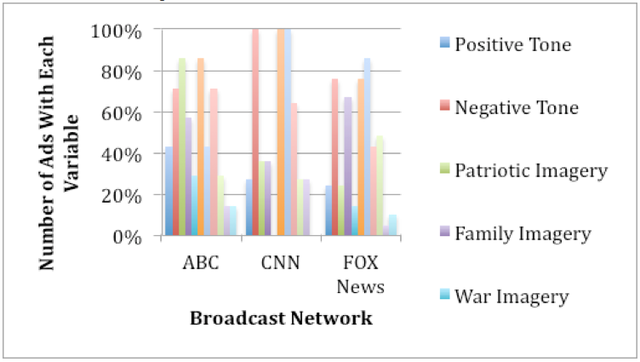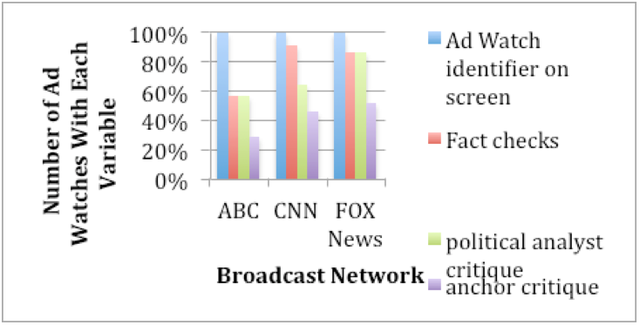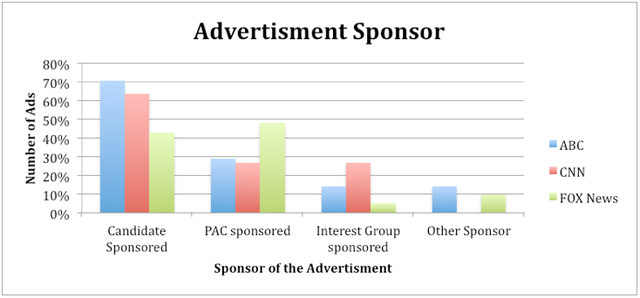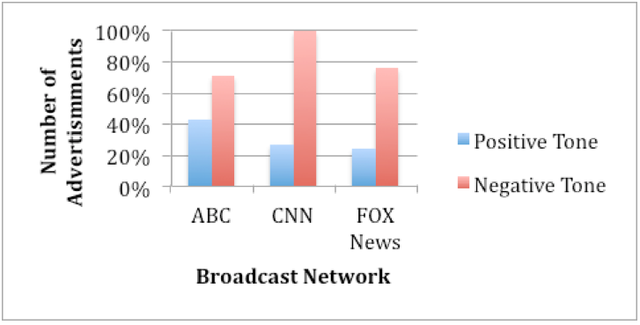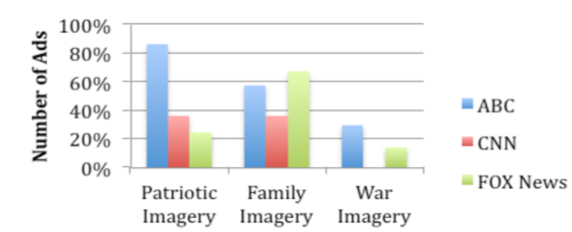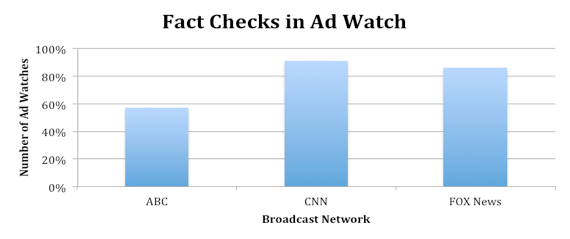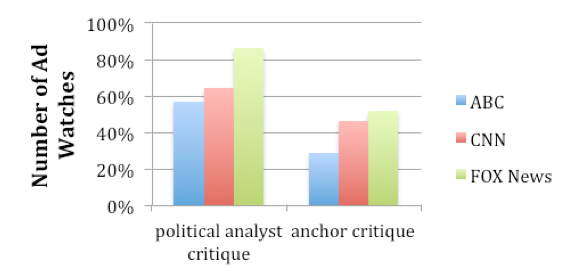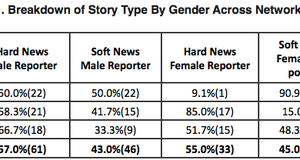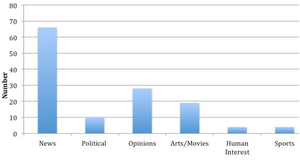From Elon Journal of Undergraduate Research in Communications VOL. 4 NO. 1Assessing Network TV Ad Watches in the 2012 Presidential ElectionIII. Research MethodTo best analyze the ad watches from the presidential election of 2012, this research relied on content analysis. Content analysis is often used when researchers are trying to analyze framing techniques. Since this study is based on the political communications technique of framing, content analysis is one of the best methods for analysis. Bernard Berelson, a researcher who is often cited for the classic definition of this method, defines a content analysis as “a research technique for objective, systematic and quantitative description of the manifest content of communication” (as cited in Stempel, 2003). To develop an effective content analysis Neuendorf has defined a nine-step process that takes the researcher through different steps, such as developing a research question to tabulating and reporting the results (Neuendorf, 50-51). To develop an effective quantitative content analysis, the researcher must have a topic, a unit of analysis, a sample, a method of operationalization, and a findings and/or analysis section (Rosenberry & Vicker, 74-75). Sample To systematically analyze and compare political advertisements in ad watches this study coded and analyzed a variety of ad watches. This study compared candidates’ advertisements and developed a deeper analysis for certain ad watches in the 2012 presidential election. Ad watches typically occur on broadcast news networks, so this study focused on three major news networks’ ad watches, CNN, ABC and FOX News (see Appendix B). These three networks were chosen for their distinctive news styles. These news outlets also have the most up to date databases of ad watches from the 2012 presidential election. Steps of Analysis Each ad watch was systematically coded to analyze the content of the ad watches and the advertisements critiqued by the ad watches. Both the ad watches and the advertisements themselves were coded for the following: tone (positive or negative), patriotic imagery, family images, war images, attacks at opposing candidate, policy, and sponsor of advertisement. In order to code the ad watches and advertisements used in them, this study employed a code sheet to track the specific characteristics of the ads. The researcher simply marked a “yes” or “no” on the code sheet (see Appendix A) for each characteristic. Once ad watches and associated ads in it were coded, the researcher compiled and evaluated all the coding together to identify trends and divergences in the data set. Taken together the coding of this data revealed new insights into this field of study. IV. FindingsCoding ad watches of the 2012 presidential campaign advertisements from CNN, ABC, and FOX News resulted in several findings. Figure 1 shows how these three networks compare in terms of the number of ad watches they performed. Each ad watch was analyzed for different variables and the advertisements used in each ad watch were also coded for different variables. Figure 1: The total number of Ad Watches on each broadcast news network
The major components of ads emerged through content analysis: attacks on the opposition, sponsor of the advertisement, focus of the advertisement, tone of the advertisement, and the presentation of war, patriotic or family imagery. The ad watches also revealed the following variables of importance: fact checking, an identifier of the campaign advertisement presented on the screen during the ad watch, the role the anchor and analysts played in ad watches. Figure 2 shows all the variables selected in analyzing the advertisements that were used in the ad watches across the three networks. Figure 2: Variables selected when Ad Watches were analyzed
Figure 3 shows all the variables analyzed to study the ad watches across the three networks. Each variable will be discussed individually later on. Below is a discussion of the findings for each of these variables and trends that emerged. Figure 3: Variables used when Ad Watches were critiqued
Variable 1: Attacks on the Opposition The first trend showed that the campaign advertisement used in ad watches attacked the opponent. When coding this characteristic, the campaign advertisement was classified as an attack on the opposition if it mentioned the opponent’s name, referenced the policy or characteristic of the opponent, or if it contrasted the candidate with his opponent. All but one of the ad watches aired on ABC used campaign advertisements where the candidate in the ad attacked the opposition. One ad watch used a non-campaign advertisement that attacked the opposition, “Chrysler Superbowl ad pro-Obama?” This ad watch was an anomaly because it was an analysis of a Superbowl ad that the Obama campaign latched onto. However, Chrysler released a statement that the advertisement was not an endorsement for Obama and had nothing to do with the Obama campaign. All ads that CNN chose for the ad watches were those that attacked the opposition. FOX News ad watches used 16 ads that attacked the opposition out of a total of 21 the network aired. Variable 2: Advertisement Sponsor This variable covered the sponsor of the campaign advertisement used in the ad watches. An advertisement used in an ad watch was coded based on its sponsor: the candidate , PAC, interest group, or others. The majority of the ABC and CNN ad watches used campaign advertisements that the candidate sponsored. The only CNN ad watch that did not use candidate-sponsored advertisements was “Truth about Romney welfare attack ad.” This ad watch used campaign advertisements that PACs sponsored. The majority of FOX News ad watches used campaign advertisements the candidate or PACs sponsored. Refer to Figure 4 for more details. Figure 4: Advertisement sponsors
Variable 3: Focus of the Advertisement This variable covered whether the campaign advertisement used in ad watches was policy centered. A campaign advertisement was coded as policy centered if the advertisement presented the opponent’s policy. ABC ad watches were more likely to use campaign advertisements that were not policy centered. On the other hand, all of the CNN ad watches used campaign advertisements that were policy centered. FOX News was also more likely than ABC to use advertisements in ad watches that were policy centered. Out of 21 advertisements, only three were not policy centered. Variable 4: Tone of the Advertisement The tone of the campaign advertisement used in ad watches was also examined. A campaign advertisement was coded for a positive or negative tone. A campaign advertisement was coded as having a positive tone if the rhetoric in the advertisement was uplifting, hopeful or overall upbeat. It was coded as having a negative tone if the rhetoric in the advertisement was accusatory, downtrodden or overall disconsolate. ABC ad watches used a mix of positive and negative toned campaign advertisements. Four of the ABC ad watches used campaign advertisements with a negative tone, and three of them used campaign advertisements with a positive tone. Overall ABC used almost an equal number of advertisements with each tone. All of the CNN ad watches used campaign advertisements with a negative tone, but some of those ads had positive tones as well. The majority of FOX News ad watches used campaign advertisements with a negative tone, 16 of the 21 ads. Based on this information, FOX News and CNN were more likely to use advertisements with a negative tone. Please refer to Figure 5 for more details. Figure 5: Tones of the advertisements.
Variable 5: Types of Imagery Utilized in the Advertisements The last variable examined for the advertisements used in ad watches was what was presented: the presentation of war, patriotism or family imagery. ABC ad watches had campaign advertisements that featured all three types of imagery with patriotic imagery being the most prevalent in ads. Very few campaign advertisements selected in the ad watches featured war imagery, and CNN ads never featured war imagery. The majority of CNN ad watches featured campaign advertisements with patriotic or family imagery, both of which were about evenly used. FOX News overwhelmingly used ads that featured family imagery. (Please refer to Figure 6 for more details.) Figure 6: Types of imagery utilized in the advertisements.
Variable 6: Fact Checking in Ad Watches Based on three variables, the ad watches were examined. The first variable is fact checking of the ad watches. An ad watch was coded as performing a fact check if the ad watch pointed out inaccurate facts, presented the actual facts that were mentioned in the campaign advertisement or presented fact checking results from other media outlets. Results showed that ABC’s ad watches did fact checking in four ad watches, not in three remaining ad watches. CNN ad watches performed fact checking in all but one. FOX News performed fact checks in all but three ad watches. Overall, this shows that most ad watches feature some sort of fact checking component. (See Figure 7) Figure 7: Fact checking in Ad Watches
Variable 7: Presentation of Campaign Advertisement Identifier on Screen The next variable examined was an identifier of the campaign advertisement that was presented on the screen during the ad watch. An ad watch was coded as having an identifier if the anchor introduced the campaign advertisement or the campaign advertisement was clearly identified as such when it was shown on the screen. All the ad watches across the three networks had identifiers on the screen or the anchor introduced the campaign advertisement during the ad watch. Variable 8: Role of the Anchor and Political Analysts in Ad Watches The final variable covered who critiqued each campaign advertisement: the anchor or political analysts. If the anchor or analyst simply stated the facts of the campaign advertisement or presented a response from either candidate, the ad watch was not coded as having an anchor or analyst critique. ABC ad watches had either analyst or anchor critique comments of the campaign advertisements. All CNN ad watches had either analyst or anchor critiques of the campaign advertisements shown in the ad watches, and most had both anchor and analyst critiques in one ad watch. FOX News was the only network that had both anchor and political analyst critiques during each ad watch. Overall, these results show that the ad watches by these major networks often involve a specific type of campaign advertisement, feature analyst and anchor critiques, often fact check the campaign advertisements, and use advertisements that do not feature war imagery. (See Figure 8 for more details.) Figure 8: Who critiqued ads in Ad Watches Suggested Reading from Inquiries Journal
Inquiries Journal provides undergraduate and graduate students around the world a platform for the wide dissemination of academic work over a range of core disciplines. Representing the work of students from hundreds of institutions around the globe, Inquiries Journal's large database of academic articles is completely free. Learn more | Blog | Submit Latest in Business & Communications |

